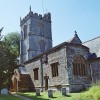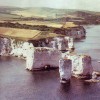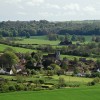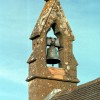More than Just a Village
Evershot is a large village nestling in a valley of chalk and Greensand in the north-west portion of Dorset, well-sheltered by blocks of beech woodland. It is situated between Beaminster and Cerne Abbas, being about 7.5 miles north-east of the former, and anciently came under the Saxon Hundred of Tollerford, now part of the diocese of Salisbury.
This village has other claims to fame. At 90 metres (625 feet) Evershot is the second highest in the county (Ashmore is the first), and is also the parish in which the River Frome has its source. The source of a tributary stream of that river, known locally as St John’s Spring, also rises within the parish, and there are the Evershot Stones (or The Three Dumb Sisters) – a group of close-standing megaliths now doubling as a public bench. A legend states that they were once three girls turned to stone for dancing on the Sabbath.
Though Evershot can accurately be described as a large village it has also been referred to by one authority as a large town. It has also been said of Evershot that “..it is a neat, clean little place with nothing worthy of notice”. Certainly in bygone days the population was considerably larger, as this included the resident yeomen farmers and tradesmen of the village and their families. Yet today the in-living population barely reaches 200, a figure that includes children, though not the hotel workers who commute in to keep the village’s vibrant tourist trade ticking over.
Tracing Evershot back to its earliest antiquity and writing a comprehensive organised history of this village has been described by one authority as an undertaking which could take years of full time research. The Dumb Sisters, a Bronze Age monument, indicate some prehistoric habitation in the parish, but otherwise Evershot can hardly be traced back further than the 12th century, when traces of Norman stonework preserved in the church were first laid.
The parish church, dedicated to St Osmund, was originally a “chapel of ease” for Frome St Quintin, though the living is now independent of the parish. In 1853 a restoration of all but the tower and chancel was carried out in Forest Marble with Ham Stone for the dressings. The style replicates early 15th century Gothic with a nave of three bays, aisles, and a south porch. The south-east corner of the tower is produced into a short spire in which a small clock face has been set. There is a peal of six bells. St Osmund’s living is a chapelry annexed, with Melbury Bubb’s rectory, to that of Frome St Quintin. The church also holds 1.25 acres of Glebe land; the parish registers start from 1694.
Some of these original St Osmund parish records of births, marriages and burials still reside in the church safe. The earliest record is of the marriage of William Groves and Sarah Gale in 1707. A descendant of William, Richard Groves, lies with his wife Elizabeth in the churchyard, their grave marked by a prominent headstone.
The local manorial estate is Melbury House & Park, home of the Strangeways family, Earls of Ilchester. The main thoroughfare, Fore Street, transects the village from east to west in a single broad arc, with side roads and lanes, most notably Summers Lane (to Cattistock) and Tanyard, off from the south. Along these streets stand a mixture of buildings ranging from 16th century through Edwardian to modern; built of stone, plaster or unadorned brick; roofed with thatch or slate. Today a doctors surgery, post office/shop, primary school, bakery, inn, hotel, and some light industry comprise the socio-economic mix of life in the village. Near to and opposite the church there are some Edwardian-style houses with bay windows and laid to lawns in the front. Beyond the church is Tess Cottage. The post office-cum-stores occupy a building with a quaint double-bay frontage.
Evershot’s principal pub-restaurant on the high street is The Acorn Inn, once also known as The Kings Arms, a traditional 16th century coaching inn which appears as “The Sow & Acorn” in Thomas Hardy’s Tess of the D’Urbervilles. This inn once brewed its own ales using water drawn from the Frome. Today the accommodation features nine on-suite bedrooms (each named after a Tess character), two oak-panelled bars, and a skittle alley-cum-function room for 60 people.
After the Church and Inn, the next institution to be established at Evershot came in 1628 when Christopher Stickland founded a Free School for “reading, writing, grammar, and the instruction and breeding of men and children”. A market was once held in the village on Saturday, but has been discontinued for many years; a fair for cattle, pigs and cloth was formerly held on May 12th. The Mummery play was also once regularly performed here at Christmas.
Evershot is one village which appears to be well-documented regarding its former male residents. The Dorset History Centre retains a hand-written notebook containing a record known as a Militia List, which notes the names and occupations of 74 of the village’s men between the ages of 18 to 50, eligible to serve in the county Yeomanry near the time of the Napoleonic Wars. The 1831 census revealed that there were living in the village: 12 cordwainers (leather boot makers); 23 labourers, 4 yeomen; 3 tanners; 3 woolcombers; 3 barbers; 2 wool staplers; 2 butchers; 2 clerks, 2 tilers; 2 plumbers, 2 thatchers, 2 hoopers (barrel makers) and one of each other occupation. Ploughmen, innkeepers, servants and shepherds, however, do not appear in Evershot’s list. For the 1841 census a population of 566 was recorded.
On the 26th of September 1865 a serious fire destroyed about 18 homes, mainly in Summers Lane, which was discovered at the home of the village’s carpenter at 1pm. Only one or two cottages survived the fire, though no lives were lost (for a full account of this tragedy see Fire at Evershot – 18 Houses Destroyed, 100 Homeless in the Evershot category). At the time of the 1871 census it emerged that there were three women blacksmiths working in Evershot!
There are some good hotels in the parish, of which the Summer Lodge Hotel must rank first, having a chequered history including a bevy of fascinating facts. Now a grade-listed building, the hotel began life as a dower house built by the 2nd Earl of Ilchester in 1798. Another two floors were added in 1893, to plans drawn up by Thomas Hardy (when still working as an architect) and a further modernisation was carried out by Lord Stavordale – the last earl to live in Dorset – in 1932. It was then vacated and lay derelict for three years from 1976 to 1979, when Nigel and Margaret Corbett bought the hotel, converting the stables and coach house into more bedrooms in 1988. Summer Lodge then came under new ownership and management in 2003, but before 2000 the property had been in the possession of only two families throughout two centuries.
In 1918 Evershot Womens Institute was founded. The Parish Council began building the village hall in 1919, though the WI could not hold its first venued meeting there until the hall was completed in 1921. When war was declared in 1939 the women were forced to meet in member’s homes after the hall was commandeered by the army. In 1996 an over 60’s Club was formed, meeting in the village bar on the third Thursday of each month (interestingly, a scene or scenes for Jane Austen’s Emma was filmed in Evershot in the same year).
As Evershot is quite small with a small population sports events are infrequent, though well-supported. The football and cricket teams meet at the Acorn Inn and play two matches a year on bank holiday weekends. The football team plays against Cattistock Fox & Hounds; the cricket team plays against the team from the Fox Inn at Corscombe. Although 16 organisations were recorded in the village in 1975, by 2002 only the Parish Council, Parochial Church Council, Playgroup and Stickland’s School were still functioning. For local transport the Weymouth branch of the Great Western Railway was routed near the border of the parish, with a station being built at Holywell, about 1.5 miles east of the church; there are bus services to Weymouth, Dorchester and Yeovil.
In 2000 the Parish Council balloted villagers for suggestions on how to best mark the Millennium. After the votes were cast about twelve project ideas were short listed, but the outright winner was an ambitious scheme to make the source of the Frome attractive to Evershot’s visitors. The work towards the project included clearing the river bank of scrub after coming to an agreement with Ilchester Estates, who own the land at the Frome’s source. The Parish Council agreed to pay an annual sum towards the maintenance of the amenity.



